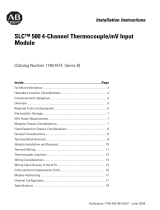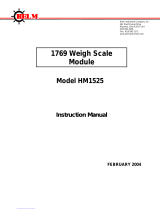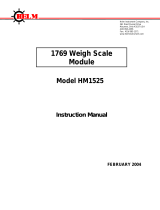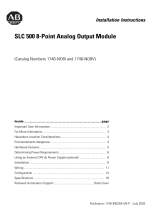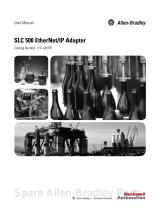
Publication 1746-UM007C-EN-P - July 2004
Table of Contents ii
Effective Resolution . . . . . . . . . . . . . . . . . . . . . . . . . . . 4-4
Channel Cut-Off Frequency . . . . . . . . . . . . . . . . . . . . . 4-5
Channel Step Response . . . . . . . . . . . . . . . . . . . . . . . . 4-6
Update Time. . . . . . . . . . . . . . . . . . . . . . . . . . . . . . . . . . . 4-7
Update Time Calculation Example . . . . . . . . . . . . . . . . 4-8
Channel Turn-On, Turn-Off, and Reconfiguration Times . . . 4-9
Response to Slot Disabling . . . . . . . . . . . . . . . . . . . . . . . . 4-10
Input Response . . . . . . . . . . . . . . . . . . . . . . . . . . . . . . 4-10
Output Response . . . . . . . . . . . . . . . . . . . . . . . . . . . . . 4-10
Chapter 5
Channel Configuration, Data, and
Status
Channel Configuration . . . . . . . . . . . . . . . . . . . . . . . . . . . 5-1
Channel Configuration Procedure . . . . . . . . . . . . . . . . . . . 5-2
Select Input Type (Bits 0-3) . . . . . . . . . . . . . . . . . . . . . 5-5
Select Data Format (Bits 4 and 5) . . . . . . . . . . . . . . . . . 5-5
Using Scaled-for-PID and Proportional Counts . . . . . . . 5-6
Scaling Examples . . . . . . . . . . . . . . . . . . . . . . . . . . . . . 5-7
Select Open Circuit State (Bits 6 and 7). . . . . . . . . . . . . 5-10
Select Temperature Units (Bit 8) . . . . . . . . . . . . . . . . . . 5-11
Select Channel Filter Frequency (Bits 9 and 10). . . . . . . 5-11
Select Channel Enable (Bit 11) . . . . . . . . . . . . . . . . . . . 5-12
Unused Bits (Bits 12-15). . . . . . . . . . . . . . . . . . . . . . . . 5-12
Channel Data Word. . . . . . . . . . . . . . . . . . . . . . . . . . . . . . 5-12
Channel Status Checking . . . . . . . . . . . . . . . . . . . . . . . . . . 5-13
Status Conditions . . . . . . . . . . . . . . . . . . . . . . . . . . . . . . . 5-15
Input Type Status (Bits 0-3) . . . . . . . . . . . . . . . . . . . . . 5-15
Data Format Type Status (Bits 4 and 5). . . . . . . . . . . . . 5-15
Open Circuit Type Status (Bits 6 and 7) . . . . . . . . . . . . 5-15
Temperature Units Type Status (Bit 8). . . . . . . . . . . . . . 5-16
Channel Filter Frequency (Bits 9 and 10) . . . . . . . . . . . 5-16
Channel Status (Bit 11). . . . . . . . . . . . . . . . . . . . . . . . . 5-16
Open-Circuit Error (Bit 12) . . . . . . . . . . . . . . . . . . . . . . 5-16
Under-Range Error (Bit 13). . . . . . . . . . . . . . . . . . . . . . 5-16
Over-Range Error (Bit 14). . . . . . . . . . . . . . . . . . . . . . . 5-17
Configuration Error (Bit 15) . . . . . . . . . . . . . . . . . . . . . 5-17
Chapter 6
Ladder Programming Examples
Initial Programming. . . . . . . . . . . . . . . . . . . . . . . . . . . . . . 6-1
Procedure . . . . . . . . . . . . . . . . . . . . . . . . . . . . . . . . . . 6-2
Dynamic Programming . . . . . . . . . . . . . . . . . . . . . . . . . . . 6-3
Verifying Channel Configuration Changes . . . . . . . . . . . . . 6-4
Interfacing to the PID Instruction. . . . . . . . . . . . . . . . . . . . 6-5
Monitoring Channel Status Bits . . . . . . . . . . . . . . . . . . . . . 6-6
Invoking Autocalibration . . . . . . . . . . . . . . . . . . . . . . . . . . 6-7




















